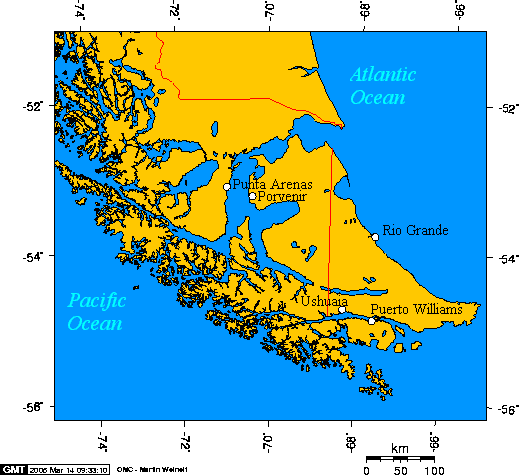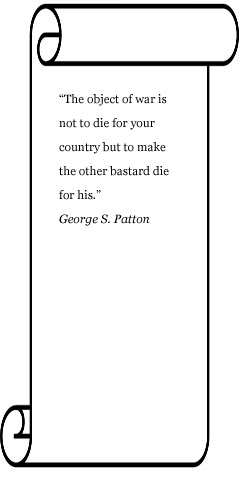| The
Beagle Channel
By Mike Bennighof, Ph.D.
March 2012
At the southern end of the American continental
land mass, the three tiny islands of Picton,
Neuva and Lennox don’t appear to have
much value to anyone but penguins. But they
have almost brought Chile and Argentina to
war with one another numerous times over the
last 125 years, thus forming an important
part of the background to our Great
War at Sea: Cone of Fire.
South America’s southern tip was pretty
much ignored by both Chile and Argentina during
the first decades of each nation’s independent
existence. The Argentine side, known as Patagonia,
is particularly desolate. The Spanish never
conquered the indigenous Mapuche people of
the region, and when Chilean and Argentine
farmers began encroaching on their lands,
the Mapuche reacted by declaring themselves
the independent nation of Araucania. In 1860
they elected a French lawyer, Orelie-Charles
Antoine de Tounens, as king.
| 
The king of Araucania.
|
King Orelie Antoine, as he styled himself,
designed a flag and some coins, but never
actually took his throne in Araucania. A pretender
still lives in France, calling himself Prince
Philippe and continuing to mint his own coinage.
The original king tried many times to assume
the leadership, but Chilean and Argentine
troops captured and deported him several times
before the Chileans nabbed him in 1862, declared
him insane, and had him locked in a French
institution.
A few years later, Welsh nationalist dreamers
concocted their own scheme for the region:
They would sponsor a mass migration of all
their people to Patagonia, where they would
found a new Wales that preserved their ancient
culture and language while outlawing written and
spoken English.
In 1879, the War of the Pacific broke out
with Peru and Bolivia allied against Chile,
a conflict over bird droppings (a valuable
source of nitrates before the development
of nitrogen fixation) made worse by the ill-defined
borders of South America. Chile greatly outmatched
the two allies in military potential, but
the allies hoped that Argentina would join
them. Such a move would swing the balance
enormously in their favor.
| 
Nitrate producers: the penguins of Punta
Tombo.
|
Chile claimed all of Patagonia, including
the Atlantic coast. Argentina, likewise,
claimed the entire region including its Pacific
coast. To keep Argentina out of the War of
the Pacific, in 1881 the Chileans agreed to
a border treaty they felt to be greatly in
Argentina’s
favor. The Argentines, for their part, were
busy with the war against the Patagonian Indians
known as the "desert conquest" and
not eager for foreign conflict. The agreed
border followed “the highest peaks
of the Andes”
all the way south to the Strait of Magellan,
curving eastward to place both sides of
the waterway in Chilean territory. It then
heads south again across the island of Tierra
del Fuego.
Off the southern edge of Tierra del Fuego
proper is the Beagle Channel, a sheltered
waterway between the big island to the north
and a string of smaller ones to the south.
The treaty names the largest of these, Navarino,
and assigns it to Chile. It does not specifically
name the three small islands at the mouth
of the channel, and this lack of precision
is the basis for the dispute.
The waters off Cape Horn (the southeastern
tip of Tierra del Fuego) are famously rough,
and a sheltered passage like the Beagle Channel
or Strait of Magellan is a desirable waterway.
If the islands are Argentine, then the mouth
of the passage lies wholly in Argentine terrirtorial
waters. If they are Chilean, then the passage
would be shared. And in more recent decades,
their possession also determines the boundaries
of each nation’s Exclusive Economic
Zone at sea — important for fisheries
and, potentially, offshore oil.

The disputed lands. Navarino is the island
with Puerto Williams; the three disputed islands
are those to the east of it.
The border treaty only kept the peace for
a short time. By 1887, Chile and Argentina
were engaged in a naval arms race. In 1891
the Chilean navy helped overthrow the president
and installed its commander, Adm. Jorge Montt,
in his place. The navy’s new influence
brought it many shiny new ships, but the civil
war had also caused tension with the United
States after rioters killed two American sailors
in Valparaiso. Argentina took advantage by
seeking an offensive alliance with the U.S.
The arms race tilted in Argentina’s
favor at the end of the decade, with the purchase
of a quartet of modern Italian-built armored
cruisers. In 1899 both nations’ presidents
met at Punta Arenas on the Strait of Magellan,
where an American mediator settled several
border questions but could not bring them
to agreement on the Beagle Channel. Both sides
continued building up their fleets. By 1902
neither truly wanted to continue the expense,
and a new set of treaties (known as the Pacts
of May) was negotiated by telegraph with the
help of British mediation. Both countries
sold off the warships they had under contract
(helping to heat up the Russo-Japanese War
in the process). The agreements defined Chile
as sovereign of the Pacific coast and Argentina
of the Atlantic — but did not define
just where the two oceans met.
Chilean troops occupied the disputed islands
in 1915. In 1958 war nearly broke out, and
again in 1978 Argentine helicopters were in
the air to deliver marines when Pope John
Paul II offered mediation. A treaty would
finally be signed in 1984, following Argentina’s
defeat in the Falklands War and the overthrow
of her murderous military junta, awarding
the islands to Chile.
In Cone
of Fire we’ve provided game
scenarios for each period of tension, including
1915, post-World War One and the 1928 crisis
touched off by Argentina’s nationlization
of her oil industry (isolating her from foreign
aid and emboldening Chile). There are also
Second World War scenarios. Chile was a firm
friend to the United States and Britain during
the conflict; Argentina maintained a more
rigorous neutrality but her economic dependence
on the Western nations would have made her
unlikely to side with the Axis powers.
Click
here to order Cone of Fire! |


